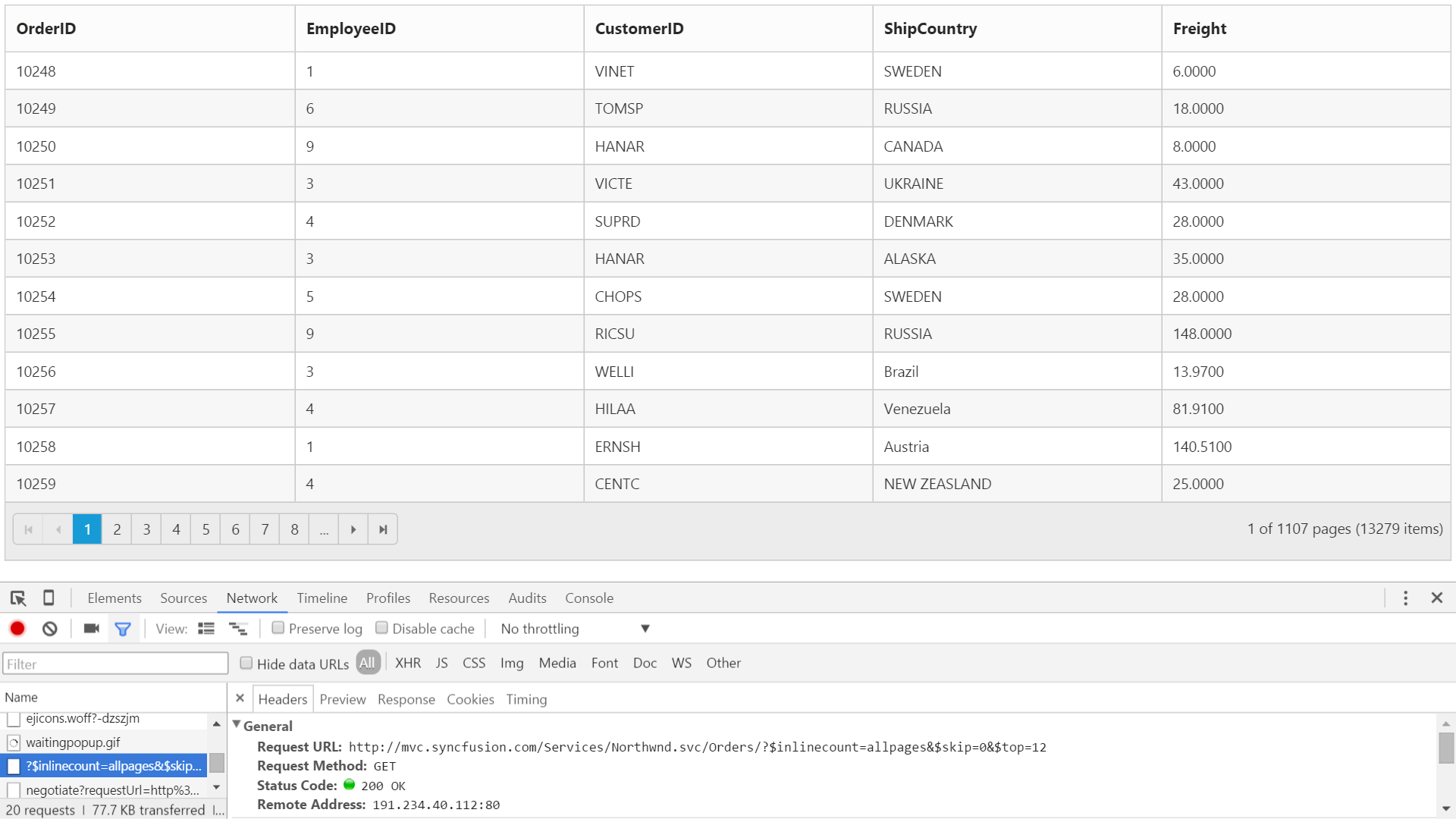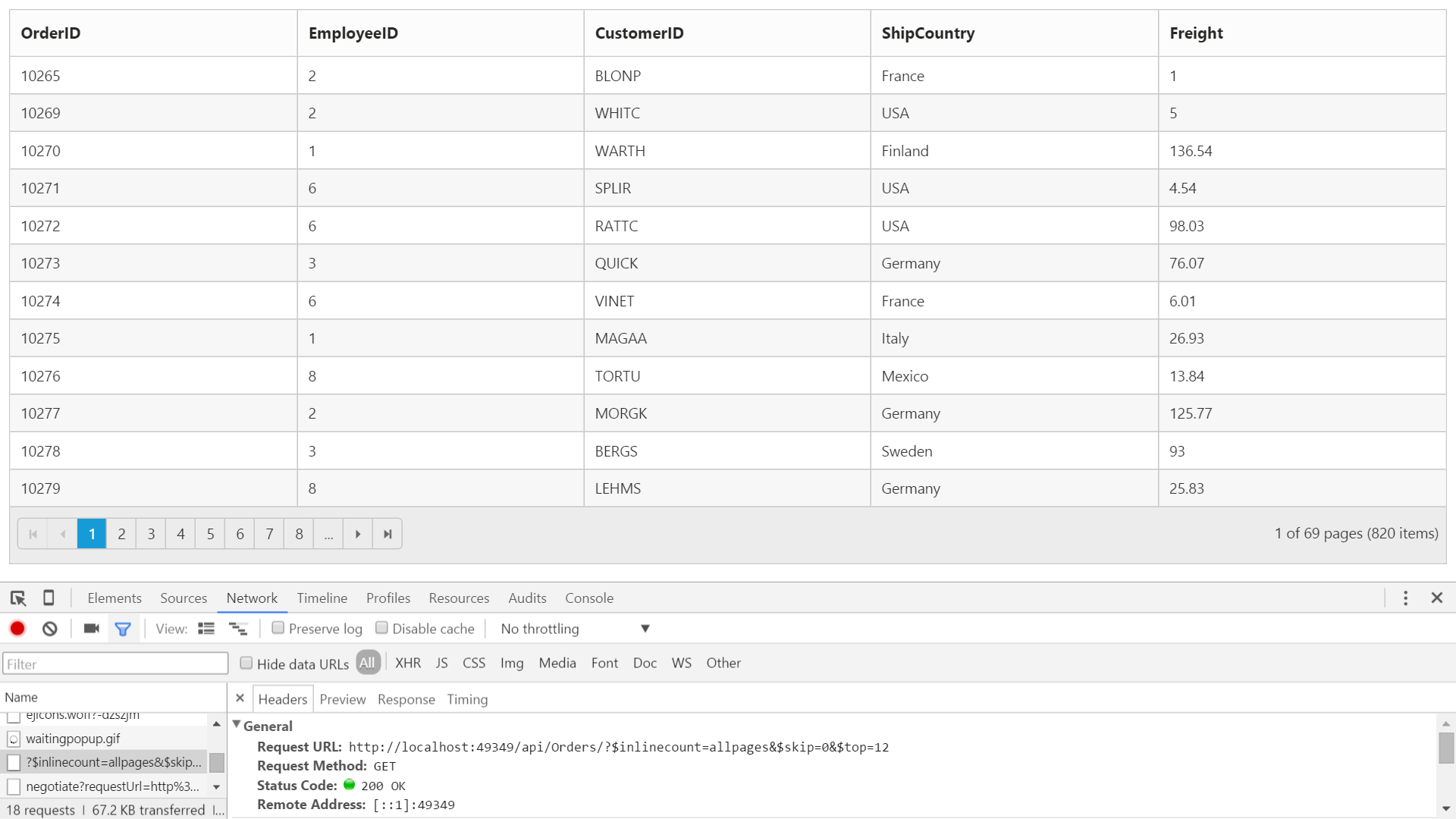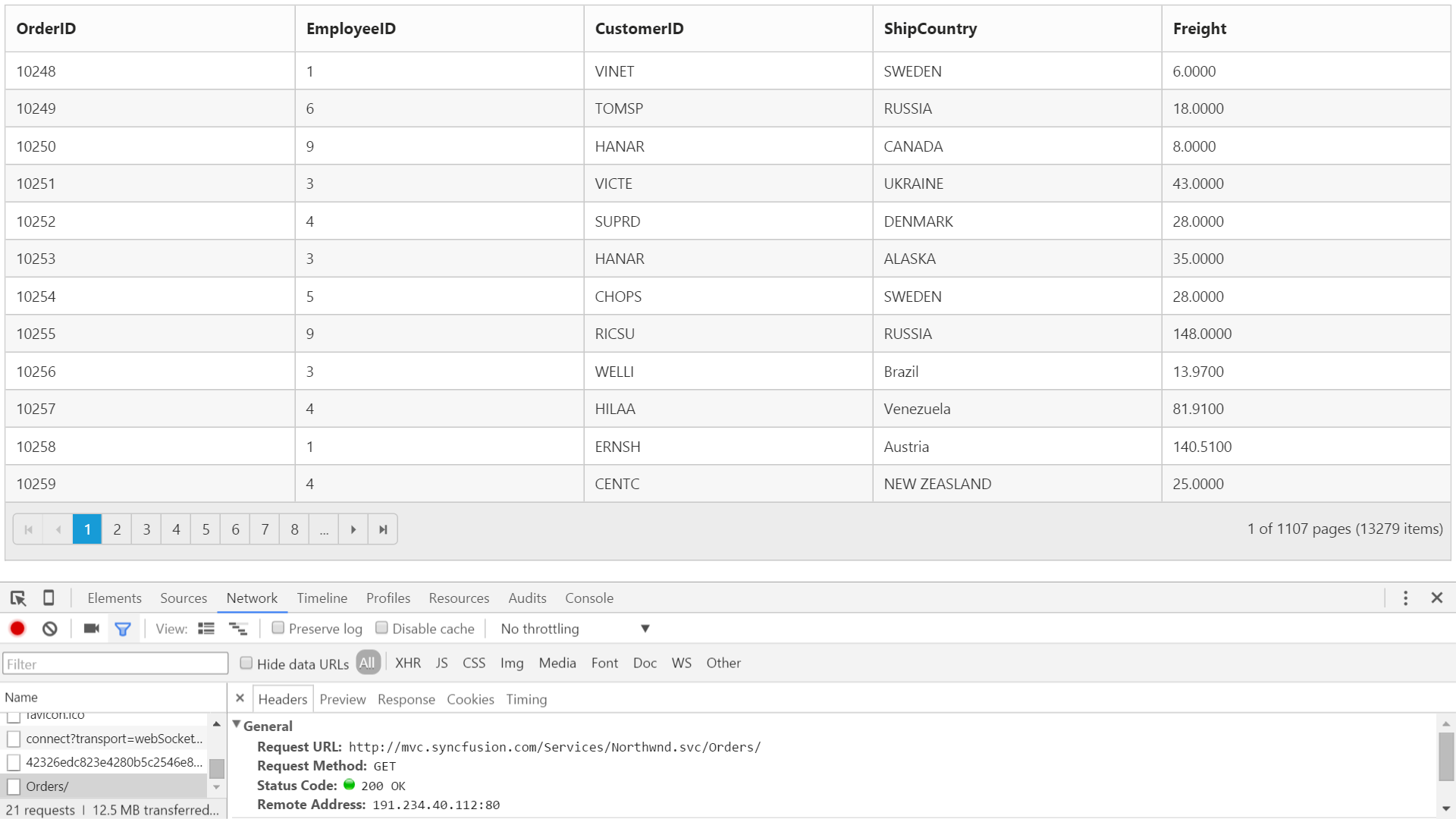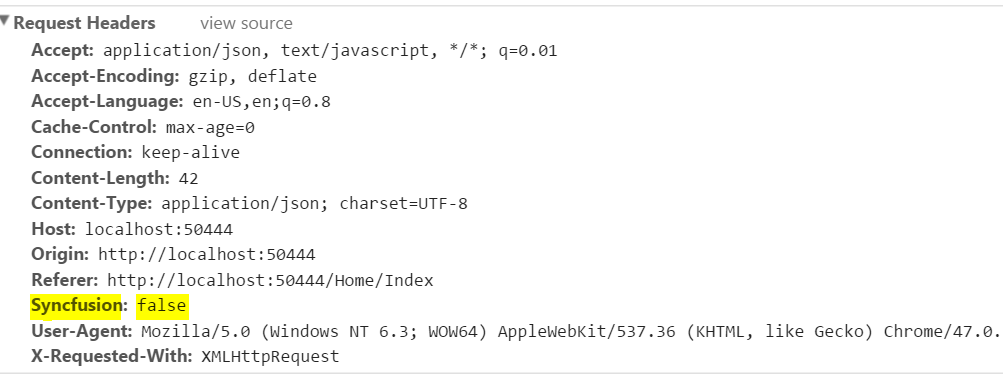Data Binding in ASPNET Core Grid
12 Jun 202324 minutes to read
The Grid datasource property or e-datamanager child tag allows to bind datasource as the instance of one of the following types.
- Collection that implements IEnumerable or IEnumerable<T>.
- REST Service URL as string.
- Table – Allows to bind HTML Table and it accepts table template script “ID”.
- ORM components such as Entity Framework/Linq to SQL.
NOTE
- To update the dataSource after Grid rendered, use
dataSourcemethod of grid.- DateTime values, retrieved from server-end or database, will be converted based on the local time zone. To avoid the local time zone conversion, refer this knowledge base link.
IEnumerable
The grid can be bound with either non-generic collection or generic collection that implements IEnumerable interface. It can be assigned to the grid’s datasource property.
NOTE
The IEnumerable datasource can be passed as either directly to the datasource property or to the json property of the child tag.
The following code example describes the previous behavior.
<ej-grid id="Grid" datasource="ViewBag.datasource">
<e-columns>
<e-column field="FirstName" header-text="First Name" text-align="Left" ></e-column>
<e-column field="LastName" header-text="Last Name" text-align="Left"></e-column>
<e-column field="Email" text-align="Left"></e-column>
</e-columns>
</ej-grid>namespace samplebrowser.Controllers.Grid
{
public class Person
{
public string FirstName { get; set; }
public string LastName { get; set; }
public string Email { get; set; }
}
public partial class GridController : Controller
{
// GET: /<controller>/
public ActionResult DataBinding()
{
List<Person> Persons = new List<Person>();
Persons.Add(new Person() { FirstName = "John", LastName = "Beckett", Email = "[email protected]" });
Persons.Add(new Person() { FirstName = "Ben", LastName = "Beckett", Email = "[email protected]" });
Persons.Add(new Person() { FirstName = "Andrew", LastName = "Beckett", Email = "[email protected]" });
ViewBag.datasource = Persons;
return View();
}
}
}The following output is displayed as a result of the previous code example.

Complex binding
The grid can display nested or navigation properties in the column that would provide the way to display the field from another entity. The complex property can be provided in the field property either as string value concatenated by dot.
The following code example describes the previous behavior.
<ej-grid id="Grid" datasource="ViewBag.datasource">
<e-columns>
<e-column field="FirstName" header-text="First Name" text-align="Left"></e-column>
<e-column field="LastName" header-text="Last Name" text-align="Left"></e-column>
<e-column field="Designation.Position" header-text="Designation" text-align="Left"></e-column>
<e-column field="Email" header-text="Email" text-align="Left"></e-column>
</e-columns>
</ej-grid>namespace Grid.Controllers
{
public class HomeController : Controller
{
public ActionResult Index()
{
List<Person> Persons = new List<Person>();
Persons.Add(new Person() { FirstName = "John", LastName = "Beckett", Email = "[email protected]", Designation = new Designation{ Position = "Manager" } });
Persons.Add(new Person() { FirstName = "Ben", LastName = "Beckett", Email = "[email protected]", Designation = new Designation{ Position = "Asst. Manager" } });
Persons.Add(new Person() { FirstName = "Andrew", LastName = "Beckett", Email = "[email protected]", Designation = new Designation{ Position = "Engineer" } });
ViewBag.datasource = Persons;
return View();
}
}
}The following output is displayed as a result of the previous code example.

WCF DataService / OData service
To consume WCF DataService in grid control, provide the service link directly to the url property of grid e-datamanager.
There is an online OData Service http://js.syncfusion.com/demos/ejServices/Wcf/Northwind.svc/Orders created specifically for Syncfusion Controls
The following code example describes the previous behavior.
<ej-grid id="FlatGrid" allow-paging="true">
<e-datamanager url="http://js.syncfusion.com/demos/ejServices/Wcf/Northwind.svc/Orders"></e-datamanager>
<e-columns>
<e-column field="OrderID"></e-column>
<e-column field="EmployeeID"></e-column>
<e-column field="CustomerID"></e-column>
<e-column field="ShipCountry"></e-column>
<e-column field="Freight"></e-column>
</e-columns>
</ej-grid>The following output is displayed as a result of the previous code example.

Web API Service
The web API Adaptor is used for processing request and response messages from Web API Service.
To consume Web API service, set the service link to the url property of grid e-datamanager and you can set adaptor type as WebApiAdaptor to the adaptor Property of grid e-datamanager
IMPORTANT
The datasource from Web API service must be returned as object that has property
resultwith its value as data and another propertycountwith its value as total records count.
DataOperation queries such as sorting, filtering, etc., would be sent to Web API Service corresponding to grid actions performed and they need to be handled manually as Web API Service does not process it by default.
The following code example describes the previous behavior.
<ej-grid id="FlatGrid" allow-paging="true">
<e-datamanager url="/api/Orders" adaptor="WebApiAdaptor"></e-datamanager>
<e-columns>
<e-column field="OrderID"></e-column>
<e-column field="EmployeeID"></e-column>
<e-column field="CustomerID"></e-column>
<e-column field="ShipCountry"></e-column>
<e-column field="Freight"></e-column>
</e-columns>
</ej-grid>public partial class GridController : Controller
{
// GET: /<controller>/
private NORTHWNDContext _context;
public GridController(NORTHWNDContext context)
{
_context = context;
}
public object Get()
{
var queryString = Request.Query;
StringValues Skip;
StringValues Take;
int skip = (queryString.TryGetValue("$skip", out Skip)) ? Convert.ToInt32(Skip[0]) : 0;
int top = (queryString.TryGetValue("$top", out Take)) ? Convert.ToInt32(Take[0]) : 12;
return new { result = _context.Orders.Skip(skip).Take(top), count = _context.Orders.Count() };
}
}The following output is displayed as a result of the previous code example.

HTML Table binding
The HTML table can be set as a data source for grid. The ID of the HTML table should be assigned to the table property of the DataManager.
IMPORTANT
HTML table is the only valid element to use through
DataManager.
The following code example describes the previous behavior.
<ej-grid id="Grid" allow-paging="true">
<e-datamanager table="#GridTable"></e-datamanager>
<e-columns>
<e-column field="Laptop" header-text="Laptop" text-align="Left"></e-column>
<e-column field="Model" header-text="Model"></e-column>
<e-column field="Price" header-text="Price" text-align="Right"></></e-column>
<e-column field="OS" header-text="OS" text-align="Left"></e-column>
<e-column field="RAM" header-text="RAM" text-align="Left"></e-column>
<e-column field="ScreenSize" header-text="ScreenSize"></e-column>
</e-columns>
</ej-grid><script id="GridTable" type="text/template">
<table>
<thead>
<tr>
<th>Laptop</th>
<th>Model</th>
<th>Price</th>
<th>OS</th>
<th>RAM</th>
<th>ScreenSize</th>
</tr>
</thead>
<tbody>
<tr>
<td>Dell Vostro</td>
<td>2520</td>
<td>39990</td>
<td>Windows 8</td>
<td>4GB</td>
<td>15.6</td>
</tr>
<tr>
<td>HP Pavilion Sleekbook</td>
<td>14-B104AU</td>
<td>22800</td>
<td>Windows 8</td>
<td>2GB</td>
<td>14</td>
</tr>
<tr>
<td>Sony Vaio</td>
<td>E14A15</td>
<td>42500</td>
<td>Windows 7 Home Premium</td>
<td>4GB DDR3 RAM</td>
<td>14</td>
</tr>
<tr>
<td>Lenovo</td>
<td>Yoga 13</td>
<td>57000</td>
<td>Windows 8 RT</td>
<td>2GB DDR3 RAM</td>
<td>11.6</td>
</tr>
<tr>
<td>Toshiba</td>
<td>L850-Y3110</td>
<td>57700</td>
<td>Windows 8 SL</td>
<td>8GB DDR3 RAM</td>
<td>15.6</td>
</tr>
</tbody>
</table>
</script>The following output is displayed as a result of the previous code example.

Miscellaneous
Load on demand
By default, the grid with remote data binding will work in On-Demand concept for which either Paging or VirtualScrolling feature should be enabled in it. It helps in improving the performance of loading a large data set.
The following code example describes the previous behavior.
<ej-grid id="FlatGrid" allow-paging="true">
<e-datamanager url="http://js.syncfusion.com/demos/ejServices/Wcf/Northwind.svc/Orders"></e-datamanager>
<e-columns>
<e-column field="OrderID"></e-column>
<e-column field="EmployeeID"></e-column>
<e-column field="CustomerID"></e-column>
<e-column field="ShipCountry"></e-column>
<e-column field="Freight"></e-column>
</e-columns>
</ej-grid>The following output is displayed as a result of the previous code example.

Load at once
The Load at once concept in grid can be used to load all data from remote service at a single request and all further grid action will be performed at client-side on the cached data.
The offline property of grid DataManager is used to enable Load at once in grid control
The following code example describes the previous behavior.
<ej-grid id="FlatGrid" allow-paging="true">
<e-datamanager url="http://js.syncfusion.com/demos/ejServices/Wcf/Northwind.svc/Orders" offline="true"></e-datamanager>
<e-columns>
<e-column field="OrderID"></e-column>
<e-column field="EmployeeID"></e-column>
<e-column field="CustomerID"></e-column>
<e-column field="ShipCountry"></e-column>
<e-column field="Freight"></e-column>
</e-columns>
</ej-grid>The following output is displayed as a result of the previous code example.

Data caching
The DataManager can cache loaded data. The caching functionality can be enabled by setting the enable-caching property in e-datamanager.
The time-till-expiration and caching-page-size properties are used to control the expiration time of data and the cache page size settings respectively.
NOTE
The window`s localStorage is used to cache the loaded data.
The following code example describes the previous behavior.
<ej-grid id="Grid" allow-paging="true">
<e-datamanager url="DataSource" enable-caching="true" caching-page-size="4" time-till-expiration="120000" adaptor="UrlAdaptor"></e-datamanager>
<e-columns>
<e-column field="OrderID" header-text="Order ID"></e-column>
<e-column field="CustomerID" header-text="Customer ID"></e-column>
<e-column field="EmployeeID" header-text="Employee ID"></e-column>
<e-column field="Freight" header-text="Freight" format="{0:C2}"></e-column>
</e-columns>
</ej-grid>The following output is displayed as a result of the previous code example.

Custom request parameters and HTTP header
Adding request parameters
The ‘addParams’ function in DataManager’s Query class is used to add additional custom parameter in data requests. The grid has an option to set default query which can be used to add custom parameter.
The following code example describes the previous behavior.
<ej-grid id="OrdersView" allow-paging="true" query="ej.Query().addParams('Syncfusion', true)">
<e-datamanager url="DataSource" adaptor="UrlAdaptor"></e-datamanager>
<e-columns>
<e-column field="OrderID" header-text="Order ID"></e-column>
<e-column field="CustomerID" header-text="Customer ID"></e-column>
<e-column field="EmployeeID" header-text="Employee ID"></e-column>
<e-column field="Freight" header-text="Freight" format="{0:C2}"></e-column>
</e-columns>
</ej-grid>ERROR
Attempting to add custom parameters with key name same as any default AJAX parameters used by the
DataManagerwill results in error.
The following output is displayed as a result of the previous code example.

Adding custom HTTP headers
The Custom header can be added through DataManager headers options. While performing, CRUD operations, the addParams cannot be used to send additional parameters to the server in such cases the parameters can be send as custom header.
The following code example describes the previous behavior.
List<Syncfusion.JavaScript.Models.KeyValue>
str = new List<Syncfusion.JavaScript.Models.KeyValue>();
str.Add(new Syncfusion.JavaScript.Models.KeyValue() {Key ="Syncfusion", Value = false });
<ej-grid id="Grid" allow-paging="true">
<e-datamanager url="DataSource" adaptor="UrlAdaptor" headers="@(str)"></e-datamanager>
<e-columns>
<e-column field="OrderID" header-text="Order ID"></e-column>
<e-column field="CustomerID" header-text="Customer ID"></e-column>
<e-column field="EmployeeID" header-text="Employee ID"></e-column>
<e-column field="Freight" header-text="Freight" format="{0:C2}"></e-column>
</e-columns>
</ej-grid>NOTE
To add custom headers to the DataManager through JavaScript, refer to this link
The following output is displayed as a result of the previous code example.

Handling HTTP Errors
During server interaction from the grid, there may occur some server-side exceptions and you can acquire those error messages or exception details in client-side using action-failure event of grid control.
The argument passed to the action-failure grid event contains the error details returned from server. Please refer to the following table for some error details that would be acquired in client-side event arguments.
| Parameter | Description |
|---|---|
| arguments.error.status | It returns the response error code. |
| arguments.error.statusText | It returns the error message. |
The following code example describes the previous behavior.
<ej-grid id="Grid" allow-paging="true" action-failure="OnActionFailure">
<e-datamanager url="DataSource" adaptor="UrlAdaptor"></e-datamanager>
<e-columns>
<e-column field="OrderID" header-text="Order ID"></e-column>
<e-column field="CustomerID" header-text="Customer ID"></e-column>
<e-column field="EmployeeID" header-text="Employee ID"></e-column>
<e-column field="Freight" header-text="Freight" format="{0:C2}"></e-column>
</e-columns>
</ej-grid><script>
function OnActionFailure(args) {
alert(args.error.status + " : " + args.error.statusText);
}
</script>The following output is displayed as a result of the previous code example.
